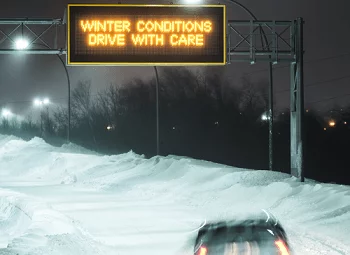
Whenever you drive, you obviously want to be as safe as possible and avoid wrecks. However, you only have so much control over accident risks even when you have a firm grip on the steering wheel. The conditions outside your vehicle pose risks too, and while you try to navigate through them safely, you can’t avoid every potential hazard. This is particularly true during the winter months.
It is no secret that winter has its own set of driving risks. Bad weather, fewer hours of daylight and an increase in traffic this time of year could always create hazards that could easily lead to a wreck if you make the wrong move. That’s why it’s important to pay attention to the road, keep your car in good condition and avoid driving in exceptionally bad weather, when possible.
Let’s take a closer look at many of the hazards on winter roadways, and what you can do to avoid them.
1. Wet & Icy Roads
Heavy rain and of course snow and ice are all conditions that might threaten both during winter and well into spring. Even after the weather front has passed, damp conditions can linger for days. Wet roadways are more difficult for vehicles to grip. That’s why you must always slow down, keep both hands on the wheel and focus on driving in these situations.
If your vehicle’s tires are not inflated properly, or if the treads on them have deteriorated to unsafe levels, then your own risk of accidents is much higher on wet roads. A damaged tire only has a harder time gripping the road than a stable one. Always keep an eye on your tires, and if you notice any signs of problems, fix them as soon as you can.
2. Long Hours of Darkness
As the days grow shorter during the winter, you will have to drive in the dark a lot more than you did during the summer. Your daytime commute from June might be a nightly commute come December.
Driving after dark is much more hazardous than driving in daylight. You don’t have the same amount of visibility, even when using your headlights. It is sometimes harder to avoid risks simply because they occur outside of your line of sight. Your reaction time might be slower and your risks of wrecks greater.
When driving in the dark, always slow down, leave extra space between you and other cars and use your headlights. When appropriate, use your vehicle’s high beams for extra protection.
3. Inclement Weather
Winter weather is perhaps the most hazardous weather for drivers. Snow and ice are equal to more than just rain. They don’t run off roadways easily, and when precipitation accumulates, it greatly reduces your ability to control your car.
Black ice, snow and freezing rain are best avoided when driving. So, if these weather risks threaten in your area, then one of the best things to do is to stay off the roads. You should only return to driving once the roads have been cleared. If your vehicle is equipped with snow tires or other winter weather features, still take proper precautions.
4. Animal Strikes
An animal strike might occur at any time of year, but deer tend to be exceptionally active during the winter months. Particularly in rural areas, these accidents might occur. Hitting an animal could cause a lot of damage to a vehicle, and even drivers and passengers in severe cases. If it happens to you, then you should immediately pull over and call for help.
Signs are posted in areas where animals frequently cross roadways. However, a deer might dart out in front of your car on any stretch of pavement. In high-risk areas, always slow down, use your lights and watch out for any movement in your periphery.
To insure your vehicle against damage done by animal strikes, you will need comprehensive physical damage insurance. This is a specific policy term that covers vehicle damage that is not related to a wreck. Animal strikes usually fall into this category.
5. Traffic Congestion and Pileups
During bad weather, holiday travel periods and even after-dark rush hours, car wreck risks are much higher because traffic tends to become congested. There are countless examples of vehicle accidents and pileups that occurred as a result of winter conditions, and none of us need any reminder of just how perilous these situations can be.
If you have a wreck when driving in winter weather, then your car insurance might help you if you have collision insurance within the policy. This coverage is separate from comprehensive insurance, and pays for wreck damage, specifically. While deductibles and other terms will apply, you can usually use collision insurance regardless of whether an accident was your fault or someone else’s.
The best thing for anyone driving in winter to do is to take their time. It is much safer to slow down, not touch your devices, keep both hands on the wheel and put plenty of space between yourself and other drivers. Even if others are not following the rules, you can only take responsibility for yourself.



